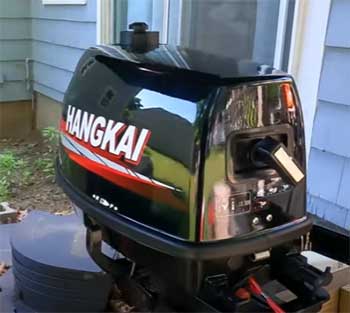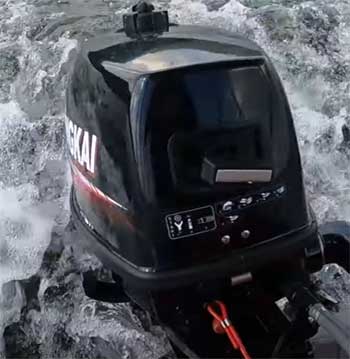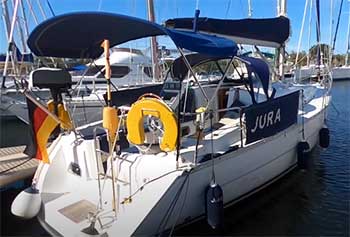If you’re in the market for a dependable boat motor that won’t break the bank, the Hangkai boat motor could be just what you need. It combines reliability with an affordable price tag, making it an excellent option for both new boaters and seasoned enthusiasts looking for a backup motor.
I’ve spent some time getting to know this outboard motor, and I’m here to share my honest thoughts on its performance, features, and whether it’s worth your hard-earned cash.
Performance of Hangkai Boat Motor

Let’s start with the basics.
The Hangkai outboard motor offers a CDI ignition system, which means it starts quickly and safely.
This is a big win, especially if you’re out on the water early in the morning or in freezing temperatures.
Personally, I found that it starts consistently within one to two pulls, even when the weather’s less than ideal—which is a huge relief when you’re out there trying to get moving as quickly as possible.
One of my favorite features has to be the 360-degree steering function. This makes reversing an absolute breeze without the need to shift gears.
On a small boat or a kayak, that’s a big plus, especially when you’re trying to maneuver through narrow channels or adjust your position without hassle.
The motor isn’t going to win any speed records, but it’s surprisingly effective for moving a loaded Jon boat or similar small vessel.
The motor is lightweight, thanks to its aluminum main rod, which makes a big difference when transporting or mounting it on smaller boats. I also appreciate the thoughtful addition of a rubber handle, which adds some comfort when driving.
Pros And Cons of Hangkai Boat Motor

Pros
- Reliable Starting: As I mentioned earlier, the CDI ignition system makes starting this motor a simple task. It’s extremely reliable, even in less-than-ideal conditions like cold temperatures. I’ve found myself pleasantly surprised when it roared to life in freezing weather after sitting unused for weeks.
- Value for Money: The Hangkai motor offers solid performance for its price. If you’re not looking to break speed records and just need a practical, no-fuss motor to get around, this model delivers. Compared to the more expensive outboards from brands like Mercury or Yamaha, the Hangkai offers a compelling budget-friendly option for light-duty tasks.
- Easy Maintenance: Maintaining the Hangkai motor is straightforward. It has an anti-corrosion system, which is essential for those who use their motor in saltwater. The motor vents also help with dissipating heat and extending the lifespan of the machine—something you’ll definitely appreciate after putting in hours on the water.
- Lightweight Construction: The aluminum main rod keeps the overall weight manageable, which is great when you’re attaching it to smaller boats. At just about 21 kg, it’s easy enough to handle on your own
- Unique Tilt Function: This motor comes with a tilt/lift function, allowing you to use it in shallow water—perfect for fishing in shallow areas or for launching from a shallow ramp. It also makes navigating underwater obstacles a lot easier.
Cons
- Manual Issues: I’ll be honest—the manual that comes with the Hangkai motor isn’t great. It’s riddled with translation errors that make it hard to follow. If you’re new to using outboard motors, you might find it frustrating, and you may need to supplement with online videos or forums to understand the maintenance procedures.
- Propeller Durability: The stock plastic propeller leaves something to be desired, especially if you’re like me and tend to encounter debris or ice chunks in the water. I highly recommend swapping it out for an aluminum propeller—it’ll cost a bit more, but it’ll improve your peace of mind when navigating tricky areas.
- No Gear Oil Included: One of the more annoying aspects of this motor is that it doesn’t come with gear oil, so you’ll have to get your own. Make sure you get the right type and fill it up before use, otherwise, you’ll risk damaging the gears—and trust me, you don’t want to deal with that.
Maintenance Tips: Getting The Most Out of Your Hangkai Motor
To keep your Hangkai motor in top shape, there are a few maintenance tasks that you absolutely can’t ignore. I’ve found that a bit of extra care can make all the difference in how well this motor performs over time.

- Break-in Period: When you first get the motor, there’s an important break-in period that involves running the motor at lower speeds for several hours. While the manual is a bit vague on this, most experienced boaters will tell you that taking it slow for the first 8 to 10 hours of use is crucial. This lets the parts settle in and helps avoid any early issues.
- Gear Oil Maintenance: Since this motor doesn’t come with gear oil, make sure you add it before your first use. It’s also wise to replace the gear oil after the first 20 hours of operation, and then regularly every 100 hours after that. This will ensure the gears stay lubricated and in good condition.
- Cleaning the Propeller and Shaft: The stock propeller is plastic, and while it’s lightweight and effective, it’s also prone to damage from debris. I recommend replacing it with an aluminum propeller. Every few uses, check the propeller and shaft for any tangled weeds or fishing lines, and remove them immediately to prevent damage.
- Cooling System: The motor’s cooling system is one of its strong points. However, make sure to frequently check the water intake to avoid blockages. If you notice overheating, the intake may be clogged with debris—clear it as soon as possible.
- Freshwater Rinse: After each use, especially if you’re boating in saltwater, rinse the entire motor thoroughly with freshwater. This will prevent corrosion and prolong the lifespan of the motor.
Also Read: Comparison of Haswing And Minn Kota Trolling Motors.
Comparing Hangkai With Other Brands
So, how does the Hangkai stack up against the competition? It’s certainly not in the same league as the premium brands like Yamaha or Mercury, but it holds its own in a specific niche—affordable and functional motors for smaller boats.
- Hangkai Vs. Yamaha
Yamaha is well-known for its high-performance, reliable motors. Comparing the two, Yamaha clearly takes the lead when it comes to build quality, performance, and smooth operation.
That said, Yamaha outboards are significantly more expensive. If you’re looking for a high-end experience, Yamaha is the way to go. But if budget is a concern, Hangkai offers a more than capable alternative at a fraction of the cost.
- Hangkai Vs. Mercury
Mercury outboard motors are another popular choice among boaters, especially those looking for high performance. Mercury’s motors are powerful and dependable, and their features tend to be well worth the price.
On the other hand, Hangkai motors cater to budget-conscious buyers. Where Mercury wins on performance, Hangkai shines on value—it’s affordable, gets the job done, and is ideal for small boats without the need for excess power.
- Hangkai Vs. Coleman
Coleman motors, like Hangkai, are a budget-friendly option. However, Hangkai outboards have a slight edge over Coleman in terms of ease of use and features like the tilt function.
From my experience, the Hangkai offers a better all-around package, especially if you’re looking for something with practical shallow-water capabilities.
Practical Use Cases of Hangkai Boat Motor
The Hangkai motor is best suited for small boats, such as Jon boats, kayaks, and inflatable boats. It’s perfect for activities like fishing, crabbing, and simply exploring calm waters.
Given its relatively low horsepower, it’s not ideal for larger vessels or for those who need speed. But if you’re after reliability, ease of use, and affordability, it’s a solid choice.
I’ve taken the Hangkai out on my 12-foot Jon boat for both solo trips and outings with friends. Even with the boat loaded down, the motor managed to push us along comfortably. It’s easy to control, doesn’t add too much weight to the setup, and offers a quiet, relaxed ride.
Also Read: Is Minn Kota Ulterra Better Than Terrova Trolling Motor?
Frequently Asked Questions (FAQ)
Yamaha and Mercury are often considered the most reliable outboard motors due to their build quality and high performance. However, Hangkai is a good budget option for those who prioritize affordability and don’t require top-tier performance.
The Hangkai 6hp motor is capable of reaching speeds of approximately 10 to 15 mph, depending on the weight of the boat and load, as well as water conditions. It’s not the fastest out there, but it’s more than adequate for small vessels and casual use.
Yamaha, Honda, and Mercury are known for their longevity, thanks to their high-quality components and robust engineering. Hangkai motors can also last a long time if maintained properly, but they do require a bit more care compared to the premium brands.
With proper maintenance, a quality outboard motor from Yamaha or Mercury can last anywhere from 1,500 to 3,000 hours. Hangkai motors may not reach that level of longevity but should provide several hundred hours of reliable use if you follow the recommended maintenance routines.
Wrapping Up
Overall, the Hangkai boat motor offers excellent value for the price, especially if you’re looking for a straightforward and affordable solution for your small boat.
It’s not without its quirks—like the lacking manual and plastic propeller—but with a little effort, it becomes a reliable and capable motor. If you’re on a budget and need something dependable, the Hangkai is a fantastic choice.

